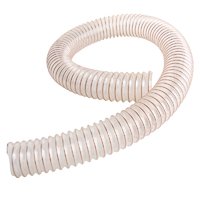How Does PU Air Duct Improve Ventilation Efficiency and Indoor Air Quality?
2025-09-28
When it comes to ventilation, one component that plays a decisive role but is often overlooked is the duct system. Among the different ducting materials available today, PU Air Ducts have gained global recognition for their durability, flexibility, and efficiency.
A PU air duct is a ventilation channel made primarily from polyurethane material. This thermoplastic polymer is well-known for its combination of strength and elasticity, making it an ideal solution for transporting air, gases, and even light dust particles in various applications. Unlike traditional ducts that may corrode, crack, or lose efficiency over time, PU air ducts provide long-lasting performance even under harsh conditions.
The growing demand for indoor air quality management across offices, factories, hospitals, and residential projects has driven industries to seek better ducting solutions. PU air ducts not only support consistent airflow but also contribute to energy savings and environmental protection by reducing leakage and enhancing ventilation efficiency.
Key Benefits of PU Air Ducts
-
Flexibility: Easy to bend and install in complex layouts without additional joints.
-
Durability: Resistant to wear, chemicals, and temperature variations.
-
Lightweight: Easier to handle compared to metal ducts, reducing installation labor.
-
Smooth Internal Surface: Promotes efficient airflow with minimal resistance.
-
Noise Reduction: Naturally dampens airflow noise, improving indoor comfort.
Product Parameters (Typical Specifications)
Below is a professional overview of common PU air duct parameters for reference:
| Parameter | Specification Range |
|---|---|
| Material | Polyurethane (PU) reinforced with steel wire |
| Temperature Resistance | -40°C to +90°C (short peaks up to +125°C) |
| Diameter Range | 25mm – 1000mm |
| Wall Thickness | 0.4mm – 1.2mm |
| Tensile Strength | High (tear-resistant design) |
| Flexibility | Excellent, suitable for tight bending radii |
| Abrasion Resistance | Strong, suitable for dust and particles |
| Standard Length | 5m – 10m rolls |
These technical features make PU ducts suitable for HVAC, industrial dust extraction, cleanroom ventilation, and even agricultural applications where both performance and reliability are crucial.
How Does a PU Air Duct Improve Airflow and Reduce Energy Loss?
One of the most frequent concerns of building managers and engineers is air leakage and energy loss within ventilation systems. Poor ductwork not only wastes energy but also undermines indoor air quality, leading to discomfort and health risks. PU air ducts directly address these challenges through their structural and material advantages.
Optimized Airflow Performance
The smooth inner lining of polyurethane ducts ensures minimal friction. This design reduces turbulence inside the duct, which translates to higher airflow efficiency. In practical terms, that means air conditioners, heaters, or ventilators need to work less to move the same amount of air, cutting down on energy bills.
Enhanced Energy Efficiency
Energy audits across commercial buildings consistently show that poorly designed ducts account for significant HVAC energy waste. By using PU ducts, leakage is minimized due to their flexibility and tight sealing during installation. Unlike rigid metal ducts that require multiple joints and connectors (which often become leakage points), PU ducts bend and fit into place seamlessly.
Resistance to Wear and Tear
In industries where ducts transport not only air but also dust or small abrasive particles, traditional ducts often deteriorate quickly. PU ducts, however, have high abrasion resistance, preventing material erosion and maintaining consistent performance over time. This durability extends service life and lowers long-term maintenance costs.
Applications Across Industries
-
Commercial HVAC: For office buildings, malls, and residential complexes.
-
Industrial Ventilation: In factories for dust collection and fume extraction.
-
Medical and Cleanroom Environments: Ensures hygienic airflow and prevents contamination.
-
Agriculture: Used in greenhouses and livestock ventilation.
With rising energy costs and stricter air quality regulations, PU ducts offer a sustainable solution for both industrial and domestic ventilation projects.
Why Should Businesses Choose PU Air Ducts Over Traditional Ducting Systems?
When planning a ventilation system, engineers often compare PU ducts with alternatives like PVC ducts, aluminum ducts, or galvanized steel ducts. Each material has its advantages, but PU consistently outperforms in a balance of performance, cost-efficiency, and longevity.
Comparison with Traditional Duct Materials
-
PU vs. Metal Ducts:
Metal ducts are strong but heavy, costly, and prone to corrosion. PU ducts are lightweight, easy to install, and resistant to rust and chemical exposure. -
PU vs. PVC Ducts:
PVC is affordable but lacks durability under high abrasion or fluctuating temperatures. PU provides better tensile strength and flexibility, making it suitable for demanding industrial use. -
PU vs. Flexible Aluminum Ducts:
Aluminum ducts are flexible but easily crushed and less resistant to wear. PU ducts maintain shape and performance under heavy use.
Cost and Maintenance Advantages
-
Installation Savings: Because PU ducts are flexible and lightweight, fewer connectors and installation hours are needed.
-
Maintenance Reduction: PU’s resistance to wear reduces frequent replacements.
-
Long-Term ROI: Even with a slightly higher upfront cost compared to PVC, PU ducts provide significant long-term savings due to reduced energy waste and longer lifespan.
Environmental Considerations
Modern industries are also under pressure to adopt more eco-friendly solutions. PU materials can be recycled and their energy-saving properties contribute to reduced carbon footprints in HVAC operations. Choosing PU ducts is not only a technical decision but also a sustainability commitment.
What Are the Common Concerns About PU Air Ducts? (FAQs and Expert Insights)
Despite their many advantages, customers often have practical questions before making a purchase decision. Here are two of the most common queries addressed in detail:
Q1: Are PU air ducts suitable for high-temperature environments?
A1: Yes. PU ducts can withstand continuous temperatures up to +90°C, and short peaks up to +125°C. This makes them suitable for most HVAC and industrial applications, except for extreme high-heat systems like industrial furnaces. Their wide temperature range also makes them reliable in both cold storage and warm air delivery.
Q2: How long do PU air ducts last compared to other duct materials?
A2: The lifespan of PU air ducts is significantly longer than PVC or aluminum ducts due to their superior abrasion resistance and tensile strength. While traditional ducts may need replacement every few years under heavy use, PU ducts often last twice as long, delivering better value and reduced downtime for maintenance.
Expert Closing Perspective
The adoption of PU air ducts is no longer limited to niche industries—it has become a mainstream choice across global HVAC and ventilation markets. Their balance of flexibility, strength, efficiency, and environmental compatibility makes them the preferred ducting solution for the future of ventilation.
As industry standards continue to prioritize air quality, energy efficiency, and sustainability, PU ducts stand out as an investment that benefits both businesses and end users.
At Geli, we are committed to delivering high-performance PU air ducts that meet international standards and serve diverse applications worldwide. For tailored solutions, technical consultations, or bulk project orders, please contact us today to discuss your requirements.



